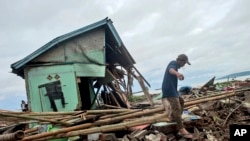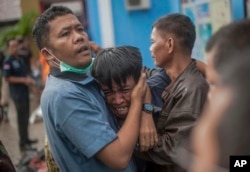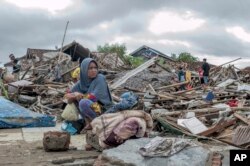The death toll from Saturday's tsunami in Indonesia rose to 373 Monday, according to disaster management officials.
At least 1,459 injuries have been reported and over 100 people are still reported missing, the Indonesian National Board for Disaster Management (BNBP) said Monday — nearly two full days after the tsunami hit the coast in the Banten province.
Over 1,000 structures, including 681 homes, have been damaged or destroyed, and some parts of the Sunda Straits area remain without electricity Monday night, according to the BNBP.
Indonesian President Joko Widodo surveyed some of the destruction Monday, visiting the hard-hit Hotel Mutiara resort at the Carita Beach in Banten province.
The Meteorology, Climatology and Geophysics Agency (BMKG) reported an eruption of the Krakatoa volcano about 9 p.m. Saturday local time, and the tsunami struck a short time later, about 9:30 p.m.
“The cause of the tsunami was due to a combination of undersea landslides after the eruption of Mount Anak Krakatoa and the tidal wave caused by the full moon," according to BMKG. However, the Indonesian Geological Agency said that they can't confirm if the tsunami was triggered by the eruption of Krakatoa, since that mountain has been erupting since last June — with even greater strength — and never caused a tsunami.
The chief of the Geological Agency, Rudy Suhendar, told VOA's Indonesian service that it was still investigating what caused the tsunami.
The casualties occurred in three regions — South Lampung in Sumatra and the Serang and Pandeglang regions of Java, west of the capital Jakarta — along the Sunda Straits, disaster agency spokesman Nugroho said in a statement.
More than 600 homes, 69 hotels, 60 shops and some 420 boats were damaged, BNBP said Monday, along with dozens of cars and other vehicles.
Jakarta resident Suhada was fishing on Carita Beach and visiting his family for the weekend when he ran from what he described as three waves between 10 and 11pm Saturday night. Suhada was able to flee to higher ground with his family.
"Thank God I could save my family," he told VOA's Indonesian service.
Disaster agency head Endan Permana told local media that many people were missing in THE tourist locale Tanjung Lesung, Banten province, near Jakarta.
The Red Cross said Banten is one of the "worst affected areas". The aid organization, however, said it was able to dispatch "relief goods" from its Banten warehouse, including water, tarpaulins, cleaning equipment, plus family and hygiene kits.
U.S. President Donald Trump tweeted about the "unthinkable devastation" caused by the tsunami, adding that "We are praying for recovery and healing. America is with you!"
The U.S. State Department also expressed its support: "Our thoughts and prayers are with all those in Indonesia affected by the natural disaster. We are currently not aware of any U.S. citizens directly affected, but stand ready to assist as needed.''
As did United Nations Secretary-General Antonio Guterres. His spokesman said the U.N. chief was "saddened by the loss of life, injuries and damages caused by the tsunami" and that the world body "stands ready to support the ongoing Government-led rescue and relief effort."
On Sept. 28, a quake and tsunami that hit near the city of Palu, on the island of Sulawesi, killed more than 2,500 and displaced about 70,000.
On Dec. 26, 2004, an earthquake in the Indian Ocean triggered a tsunami that killed 226,000 people in 13 countries, including more than 120,000 in Indonesia.
VOA's Indonesian Service contributed to this report.









